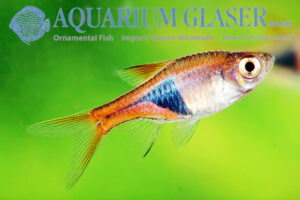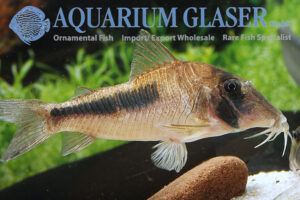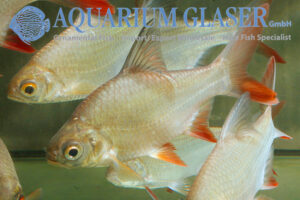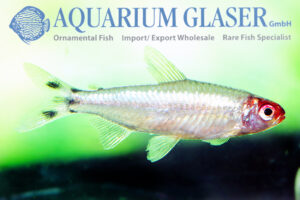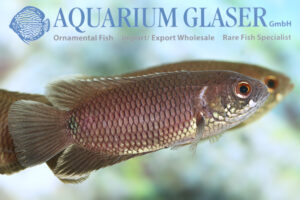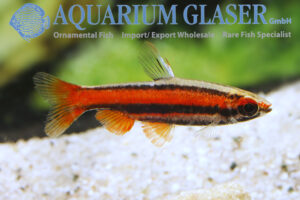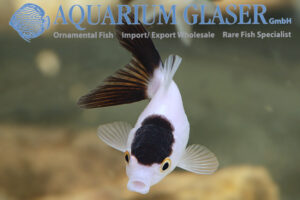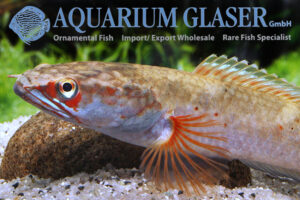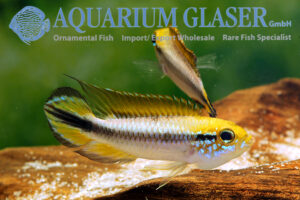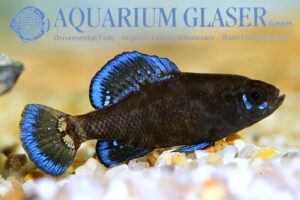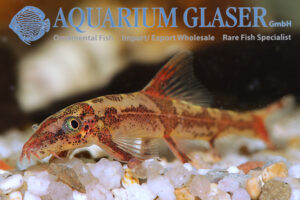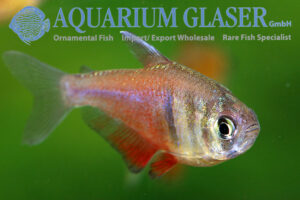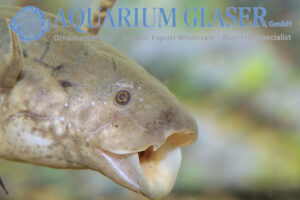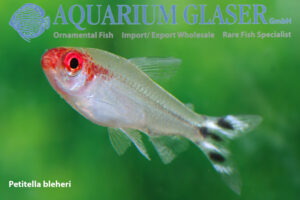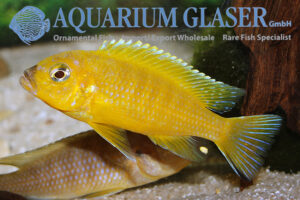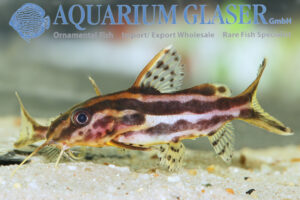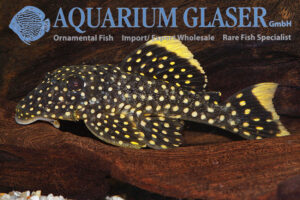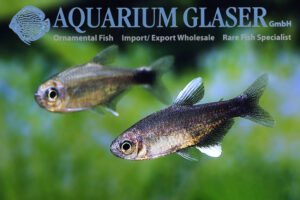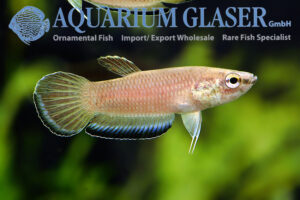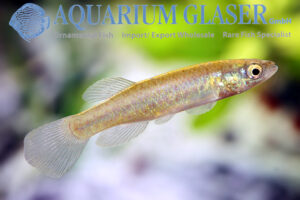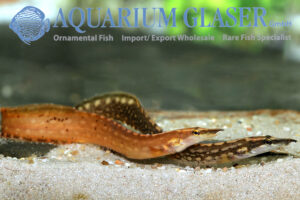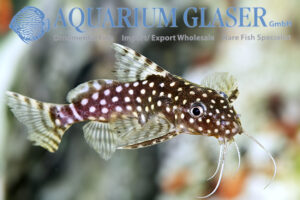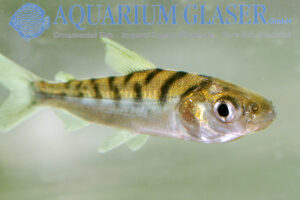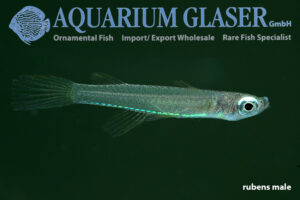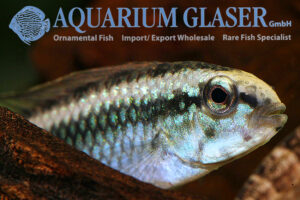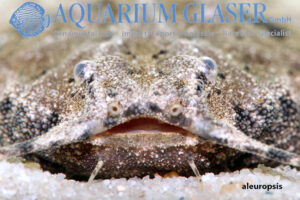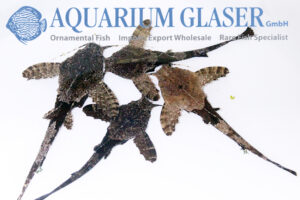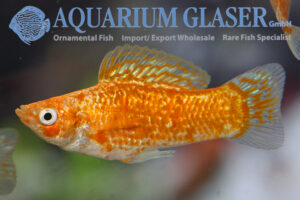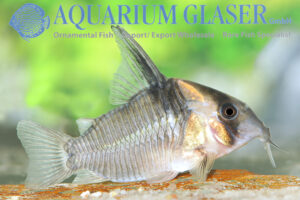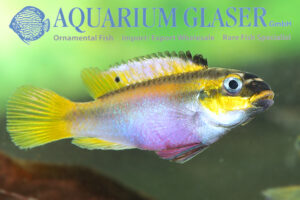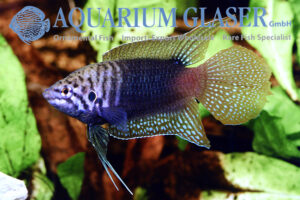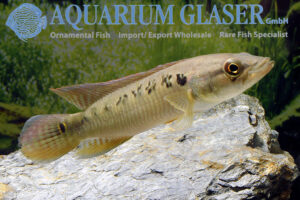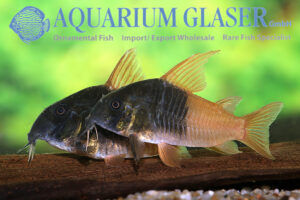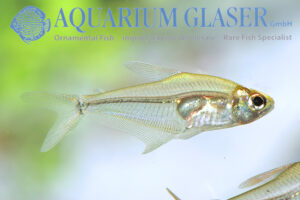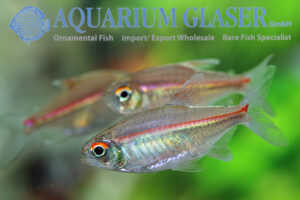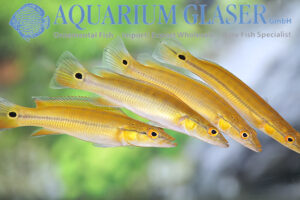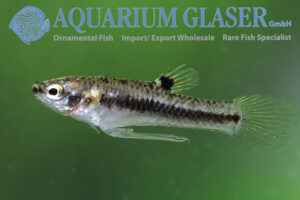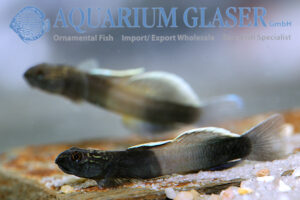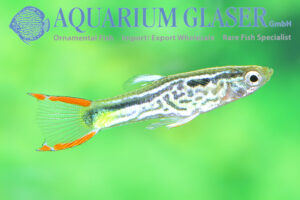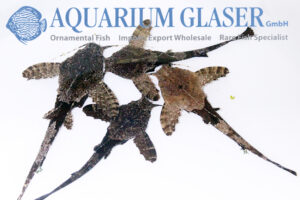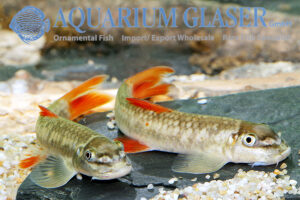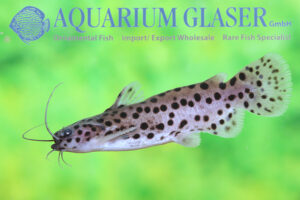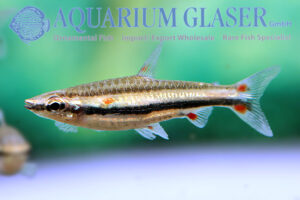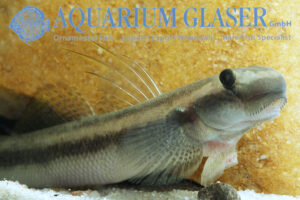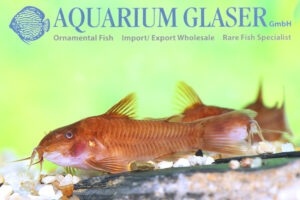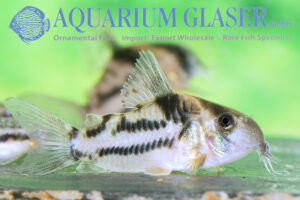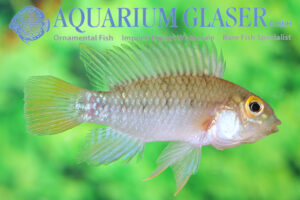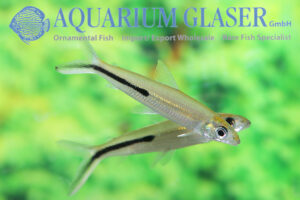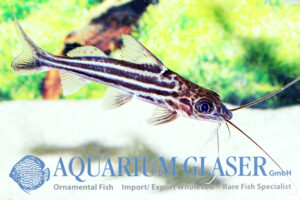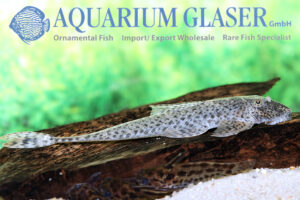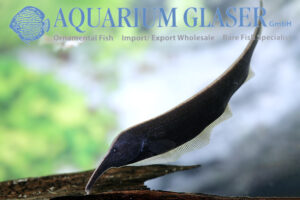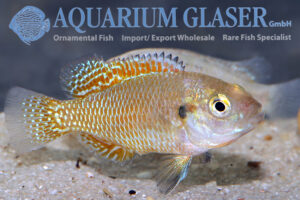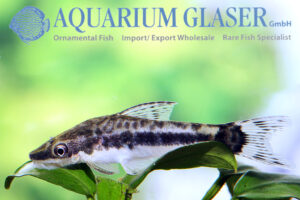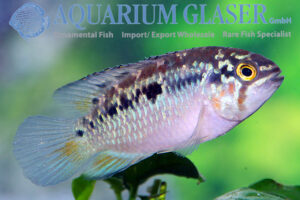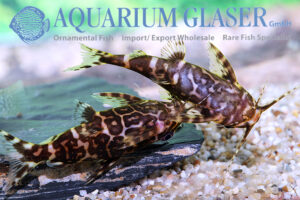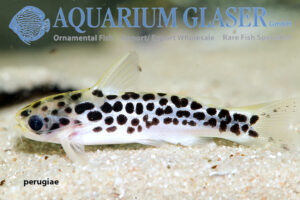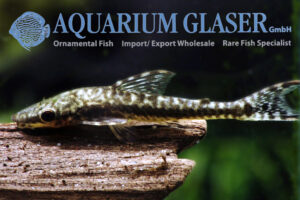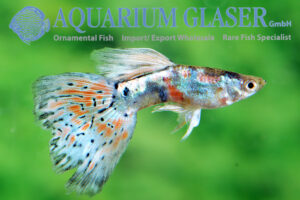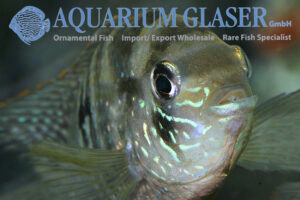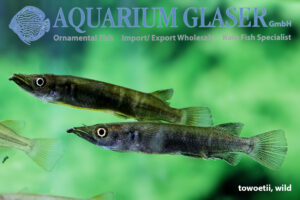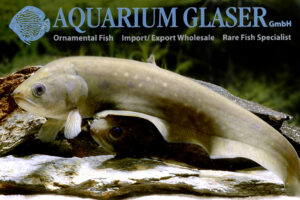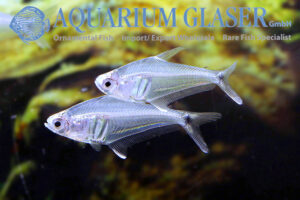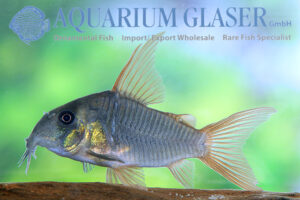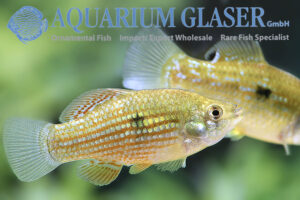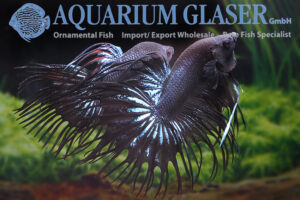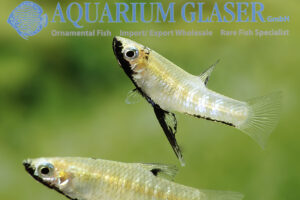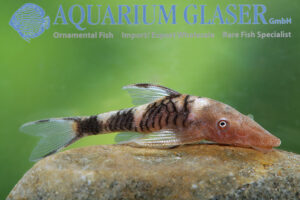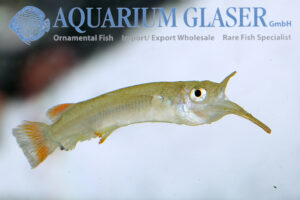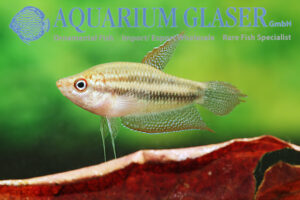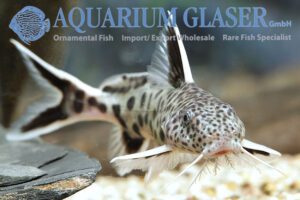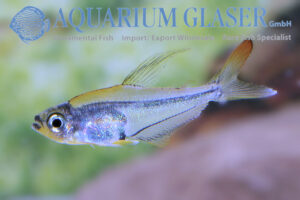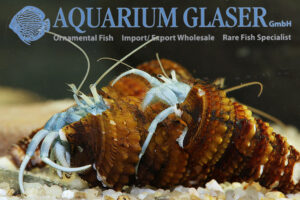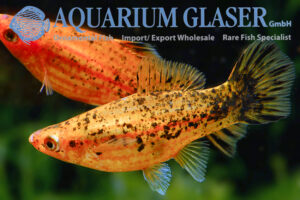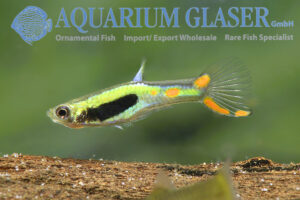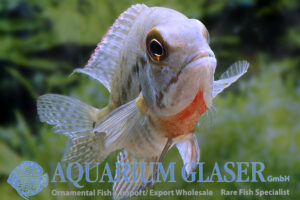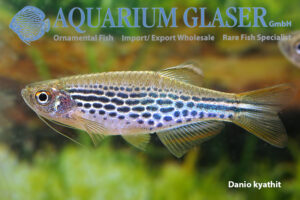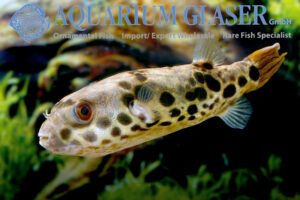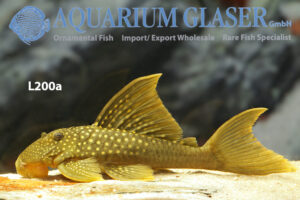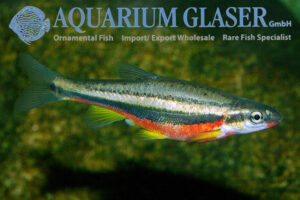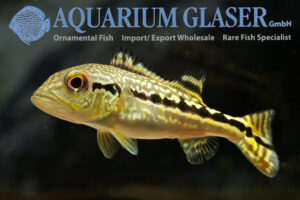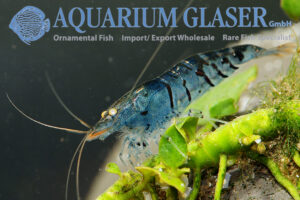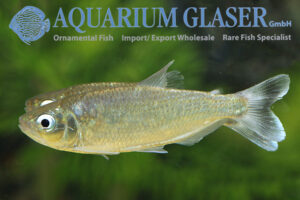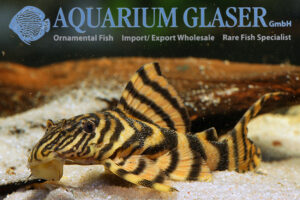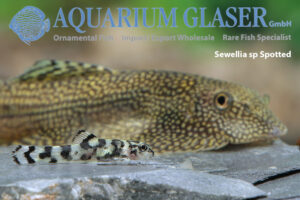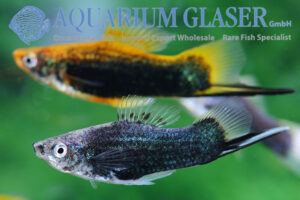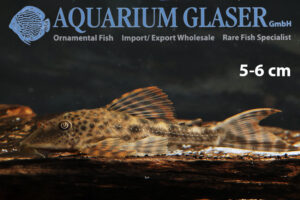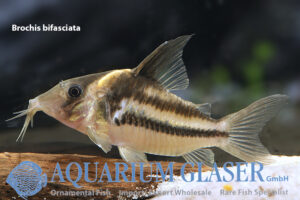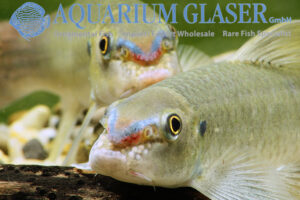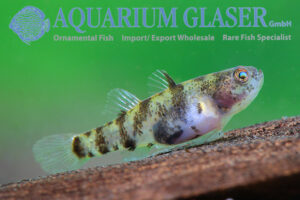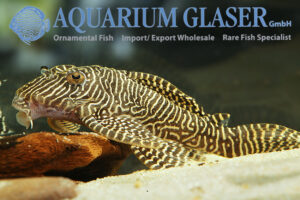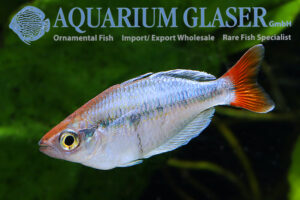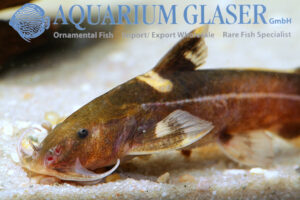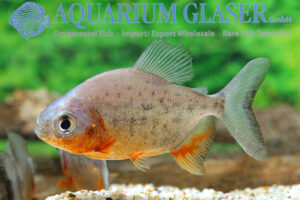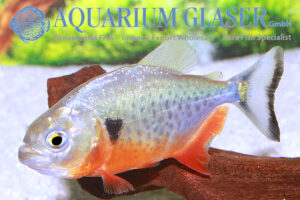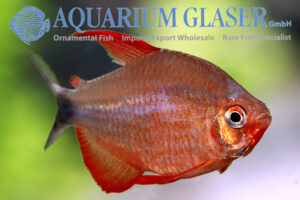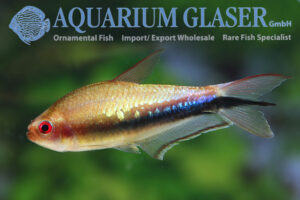The harlequin barb, Trigonostigma heteromorpha (formerly Rasbora h.), is one of the most important aquarium fish of all. For this reason, it is traded almost exclusively as a captive-bred species, as the availability of wild-caught fish fluctuates greatly due to seasonal conditions (during the rainy season, the natural habitats are often inaccessible for months). In […]
Fish Archive (3137)
-
-
Corydoras amapaensis
Finally we were able to import again a small number of the extremely rarely offered long snouted Corydoras amapaensis. The distribution range of this extraordinary species lies in the Oyapock and Amapari river basins in the state of Amapá in Brazil and in French Guiana. The species is highly variable in respect of coloration. The […]
-
Barbonymus schwanefeldii
One of the largest Asian barbs imported for aquarium keeping is Barbonymus schwanefeldii. It used to be known formerly as Barbus. This species, native to Borneo, Malaysia, and Thailand, grows up to 35 cm long. The red coloration of the tail fin is wonderful and is found in this intensity in hardly any other fish. […]
-
Petitella bleheri „PLATIN“
So-called gold tetras are found in many species of characins in South America. Usually, only a few fish in a school are affected by the phenomenon in which guanine, the substance responsible for the shiny silver or gold glitter effect of the fish scales, is secreted at a much higher rate than usual. We explain […]
-
Ctenopoma kingsleyae
The tailspot bushfish (Ctenopoma kingsleyae) originates from wooded areas in western Africa. It was one of the first labyrinth fish exported from Africa for aquariums. The first specimens from the lower Niger region arrived in Germany as early as 1912. Strangely enough, this calm, peaceful species was described at the time as very aggressive and […]
-
Nannostomus mortenthaleri
Nannostomus mortenthaleri from Peru (Rio Nany tributary in the province of Loreto) was the most beautiful new discovery in aquatics in 2000. The close relative of the dwarf pencil, N. marginatus, remains small – approx. 4 cm – and is breathtakingly beautiful in color in the male sex. At least sometimes. Because apart from anatomical […]
-
Carassius auratus Oranda Panda
Black and white goldfish are referred to as “magpie-colored” in breeding circles, fish with telescope eyes as “Demekin,” and those with a simple double tail fin as “butterfly tail.” An Oranda, on the other hand, is a goldfish with a hood, in breeding terms. Accordingly, the cute pandas that we were finally able to import […]
-
Channa pyrophthalmus ( = sp. Fire & Ice)
At the beginning of 2024, this snakehead species, which had long been known in the hobby as Channa sp. Fire & Ice, was scientifically described as Channa pyrophthalmus. So far, it is only known from the extreme southern border area between Burma and Thailand. We are currently able to offer this small and colorful Channa […]
-
Apistogramma agassizii PUTUMAYO
For the first time, we are able to offer a small number of this “new” variant of the well-known Apistogramma agassizii. They were originally by-catches of the magnificent Putumayo variant of A. bitaeniata from Peru (see https://www.aquariumglaser.de/en/fisharchive/apistogramma-bitaeniata-putumayo-4/). We raised a few specimens to see what would become of them, and we can only say: it […]
-
Elassoma gilberti
This species of pygmy sunfish was only formally described scientifically in 2009. It originates from Florida and Alabama, where it occurs alongside (but not together with) the very similar species E. okefenokee. Like all pygmy sunfish, they are small fish, with males reaching a maximum total length of 3 cm; females remain smaller. The sexes […]
-
Homaloptera ogilviei
Hillstream loaches belong to the loach family. The most beautiful representatives are found in the genus Homaloptera. Until a few years ago, this genus was very broadly defined; 72 species were described as Homaloptera spp. Today, however, the definition of the genus is much narrower and only six species are assigned to the genus Homaloptera: […]
-
Hyphessobrycon flammeus
One of the first tetras ever imported for aquariums is Hyphessobrycon flammeus. Since its first import in 1924, the species has never disappeared from aquariums, as it is easy to breed and the fish are very productive. Due to its origin (the area around Rio de Janeiro in Brazil) and its pretty red color, the […]
-
Protopterus annectens Nigeria
There are four species of lungfish in Africa, some of which are difficult to distinguish from one another. The situation in Congo is particularly confusing (see https://www.aquariumglaser.de/en/29-lungfishes/lungfishes-from-the-congo/). Only the species Protopterus dolloi is always easy to recognize due to its elongated body shape. The surest way to distinguish between the three species Protopterus aethiopicus, P. […]
-
Petitella – Rummynose Tetras
The rummynose tetras are a beautiful eye-catcher for any aquarium with peaceful fish. A shoal of these animals, and there should always be 15 – 20 specimens if possible, delights every observer because these animals really do swim permanently in a shoal; the vast majority of so-called shoal fish among aquarium fish do not do […]
-
Maylandia sp. „Daktari“
The colorful rock cichlids (Mbuna) of Lake Malawi are mainly kept for their bright colors, but they actually have more to offer in terms of behavior than just looking good. Maylandia sp. Daktari—a species not yet scientifically described—occurs only in a relatively small area in four populations; two of these populations are indistinguishable in appearance. […]
-
Synodontis flavitaeniatus
This attractive squeaker catfish originates from the lower Congo (for example in the Pool Malebo area, formerly known as Stanley Pool). With a final size of around 20 cm, it is one of the medium-sized species of the genus. In the past, this catfish was considered to be as sensational as the zebra catfish (L46, […]
-
Baryancistrus xanthellus L18
The fishing season for the beautiful Golden Nugget catfish of the genus Baryancistrus lasts from around the end of May to the end of September. Due to the varying sizes of the spots on their bodies and the varying widths of the fin edges on their dorsal and caudal fins, as well as the varying […]
-
Hyphessobrycon negodagua
At present the small tetras of South America experience a new boom. Numerous species have been and are being described scientifically. Thus also the ornamental fish collectors leave their beaten tracks and look for these animals, particularly since initially peppered prices are paid for the novelties. Naturally, such a thing only works for a short […]
-
Betta simplex
This small (5-6 cm) mouthbrooding species from Thailand is a very nice addition to the assortment of wild collected Betta we occasionally have in stock. Betta simplex is a close relative to the species Betta picta from Java, Betta falx from Sumatra, and Betta taeniata from Borneo. All the mentioned species share obviously the same […]
-
Fundulus julisia
The global loss of biodiversity, i.e., species diversity, is terrible. People who are particularly interested in nature, and this includes aquarists in particular, feel the extinction of species almost as physical pain. Small fish species are among the few organisms that are very well suited for conservation breeding over a very long period of time […]
-
Mastacembelus unicolor
The large (around 60 cm) spiny eel Mastacembelus unicolor was scientifically recorded early on. The two researchers Kuhl and van Hasselt discovered it in the western part of Java during their stay there from 1820 to 1823 and also made a drawing of the animal. The two paid for their thirst for knowledge with their […]
-
Synodontis angelicus
With 133 species, the squeaker catfish (Synodontis) inhabit practically the entire African continent. The smallest species grow to 6-7 cm in length, the largest to 60-70 cm. They play a very minor role in aquariums. Only the Upside-Down catfish (Synodontis nigriventris) and a few species from Lake Tanganyika are true aquarium fish with a larger […]
-
Curimata vittata
The genus Curimata currently comprises 13 species; only one of these occasionally finds its way into our aquariums, namely Curimata vittata. The other species simply offer no incentive to keep them. They are shiny silver-colored animals that can reach a length of 15-20 cm and feed mainly on plant material. Curimata vittata also reaches this […]
-
Fluviphylax rubens
The miniature lampeyes of the genus Fluviphylax are the smallest relatives of killifish. When fully grown, their body length is less than 2 cm standard length (i.e., without the tail fin), usually around 1.5 cm. Until recently, these dwarfs were only known from Brazil, from where we were occasionally able to import them, but that […]
-
Apistogramma flabellicauda
There are three species of Apistogramma that even a very experienced Apistogramma enthusiast cannot reliably distinguish from one another: A. uaupesi (scientifically described in 1980 from the Rio Uaupes in Brazil, previously given the common name “segelflossen ( = sailfin) apistogramma” by Schmettkamp, later referred to by various authors as “red-wedge ( = rotkeil)” or […]
-
Bunocephalus aleuropsis and B. colombianus
We received four larger (10-15 cm) banjo catfish from Colombia, which turned out to be four different species. The two Xyliphius specimens were identified relatively quickly; one is a specimen of X. lepturus and the other is an almost entirely black specimen of X. melanurus (see https://www.aquariumglaser.de/fischarchiv/xyliphius-cf-lepturus-und-x-cf-melanurus/). The two “real” Bunocephalus were more difficult to […]
-
Bunocephalus coracoideus
Banjo catfish (Bunocephalus) are extremely common in nature. That’s why we always have them in stock. We usually refer to these animals as Bunocephalus coracoideus, which may be correct in many cases. But when you look at such a swarm of banjo catfish, you notice that there are always other species mixed in. As a […]
-
Silver Molly Orange Spots
Whenever one of our suppliers offers a “new variety,” we order a box to see what it is. However, we know from experience that the term “new variety” is often used very flexibly. The spectrum ranges from “old news, but new to our list” to “wow, we’ve never seen anything like this before.” This time […]
-
Hoplisoma colossus ( = CW45, Corydoras sp. „Lessex“)
In 2009, we successfully imported a large, beautiful armored catfish from the Rio Jutai in Brazil for the first time. At the time, we referred to the animals as Corydoras sp. aff. armatus because their particularly high dorsal fin and general body shape were very reminiscent of C. armatus. However, C. armatus (current name: Hoplisoma […]
-
Pelvicachromis kribensis “Nyété” (formerly P. taeniatus “Nyété”)
The city of Niété is located in the southern part of Cameroon and is part of the Océan department in the South Province. It is traversed by the Nyété River, which is a tributary of the Lobé River. The beautiful Pelvicachromis kribensis occurs there in a special color variant known in the hobby as “Nyété.” […]
-
Macropodus ocellatus
The roundtail or Chinese paradise fish (Macropodus ocellatus, formerly M. chinensis) is a fish for connoisseurs and experts. For connoisseurs because it is extremely inconspicuous in its plain plumage – i.e. as a rule in the dealer’s tank. Those who are not familiar with it will therefore usually not buy it. But connoisseurs know: in […]
-
Saxatilia sveni (formerly: Crenicichla sveni)
From Colombia (Rio Meta basin), we have obtained Saxatilia sveni, which is very rarely imported, together with Crenicichla (Batrachops) sp. “Belly Crawler” ( = C. sp. aff. sedentaria), which also occurs there. This representative of the former Crenicichla saxatilis group, which is currently grouped in a separate genus Saxatilia, grows to a considerable size, 25-30 […]
-
Crenicichla (Batrachops) sp. “Belly Crawler”
The genus Crenicichla was once the largest of all cichlid genera, with 139 scientifically described species, 93 of which are generally recognized as valid species. In addition, there are a large number of species that are already known to aquarists but have not yet been scientifically studied. The genus has since been subdivided (see https://www.aquariumglaser.de/en/25-perchlike-fishes/the-crenicichla-have-been-reclassified/). […]
-
Hoplisoma sp. aff. concolor Rio Tomo CW217
We consider the import of this beautiful new Hoplisoma to be sensational. According to the supplier, it comes from a small tributary of the Rio Tomo in eastern Colombia. The fishermen refer to this tributary as Cano Negro. The water is described as “crystal clear.” The Rio Tomo itself is a tributary of the Orinoco, […]
-
Phenacogaster cf. capitulata
Currently (September 2025), 28 species are assigned to this genus. The genus was established in 1907 by Eigenmann for the species Tetragonopterus pectinatus, described in 1870 by Cope from Peru (Pebas). Cope’s description was not accompanied by any illustration, so Fowler drew the holotype in 1907, which he classified in the genus Astyanax. Based on […]
-
Hyphessobrycon acaciae
Imagine you have a first import and don’t even realize it! That’s what’s happening to us right now with a tetra. We received some very beautiful, large Hemigrammus coeruleus from Colombia. At least, that’s what we thought. By chance, Peter and Martin Hoffmann, from whom we often and gladly receive rare tetra offspring, needed a […]
-
Lugubria sp. Xingu1 (formerly: Crenicichla)
In the 1990s, when Brazil’s large river cichlids experienced something of a boom, four species from the former collective genus Crenicichla also arrived in Europe for the first time. Due to the lack of a scientific name, they were designated Crenicichla sp. Xingu I – IV. All four grow to a considerable size for ornamental […]
-
Heterandria formosa
In old aquarium books, you can still read that the males of the Least Killifish (Heterandria formosa) could claim the title of “smallest fish in the world.” They grow to a maximum length of only about 2 cm, which is significantly smaller than the females, which grow to a length of up to 3.5 cm. […]
-
Lentipes dimetrodon
This dwarf goby, a relative of the of neon gobies (Stiphodon), was scientifically described in 1999. To date, the species is only known from coastal rivers in western New Guinea (Irian Jaya). However, since it undergoes its juvenile development in the sea, like all sicydiine gobies, it is more than likely that it is much […]
-
Glossolepis dorityi
We have once again received offspring of this beautiful rainbow fish. For basic information, please refer to this post: https://www.aquariumglaser.de/en/17-rainbow-fishes-and-co/glossolepis_dorityi_lake_nenggwambu__en/ Unfortunately, it is quite likely that Glossolepis dorityi, which was only scientifically described in 2001, is already extinct in the wild. We quote here from the entry in the International Red List (IUCN): “This species […]
-
Poecilia wingei Endler Guppy Campoma No 46
It is not without reason that guppys are among the most popular ornamental fish in the world, ranking high in the top ten. The play of colors is almost endless. This applies to the “classic” guppy Poecilia reticulata as well as its slightly smaller cousin P. wingei, the Endler guppy, and the countless hybrids that […]
-
Bunocephalus coracoideus
Banjo catfish (Bunocephalus) are extremely common in nature. That’s why we always have them in stock. We usually refer to these animals as Bunocephalus coracoideus, which may be correct in many cases. But when you look at such a swarm of banjo catfish, you notice that there are always other species mixed in. As a […]
-
Garra qiaojiensis
Many good aquarium fish have come to us from the extremely species-rich genus Garra. The “doctor fish” Garra rufa (https://www.aquariumglaser.de/en/fisharchive/garra-rufa-2/), Garra flavatra (https://www.aquariumglaser.de/en/08-carp-like-fishes-2-barbs-minnows-carps-goldfish-etc/garra_flavatra_en/) is very pretty, and Garra panitvongi (https://www.aquariumglaser.de/en/fisharchive/garra-panitvongi-sp-red-tail-2/) is bizarre and beautiful. Now we received two specimens of a Garra species as samples, whose beauty took our breath away. This is Garra qiaojiensis, […]
-
Spinipterus moijiri
The discovery of a new genus of driftwood catfish—Spinipterus—is quite sensational. In 2011, the first species of the newly described genus (S. acsi) was described and the new genus was established for it. In 2019, the second species (S. moijiri) was added, which is significantly more attractive in appearance and displays a beautiful jaguar pattern […]
-
Nannostomus erythrurus
The three-banded pencilfish, Nannostomus trifasciatus, is one of the most popular ornamental fish. It combines numerous characteristics that make it desirable: beautiful coloration, peaceful nature, small size, and easy feeding. However, few people know that the name “Nannostomus trifasciatus” actually refers to several species. The “real” N. trifasciatus is relatively rare in stores. It comes […]
-
Sicyopterus microcephalus (incorrectly imported as S. longifilis)
The genus Sicyopterus comprises the largest species of the increasingly popular sicydiine gobies, which include Stiphodon, Sicyopus, Sicydium, Lentipes, and others. All of these gobies undergo their larval development in the sea, while the adults live in pure freshwater and lay their eggs there. Since the larvae have hardly any yolk reserves, they must be […]
-
Aspidoras raimundi C125 Red
The genus Aspidoras has recently undergone a revision, resulting in several regroupings. Among other things, the species A. menezesi and A. spilotus, well known at least by name in the hobby, have been synonymized with A. raimundi. Cory-catfish enthusiasts agree that C125 and CW119 also belong here. More information on the wild type of A. […]
-
Hoplisoma sp. CW127 BRED
One of the most magnificent armored catfish to become available in recent years is undoubtedly the CW127 from the Rio Jamanxim. For more information, see https://www.aquariumglaser.de/en/fisharchive/corydoras-sp-aff-parallelus-cw127-4/ We now have German captive-bred specimens of these magnificent animals in stock for the first time. For our customers: the animals have code 240262 on our stock list. Please […]
-
Apistogramma eunotus “Orange Tail”
In this day and age, when absurd debates are being held about banning private animal husbandry as far as possible (“positive list”), we must always remember the great successes that have been achieved with many fish groups thanks to the aquarium hobby. The genus Apistogramma is a prime example of this. Until 1977, 31 species […]
-
Hemiodus semitaeniatus
With 23 species, the genus Hemiodus is quite species-rich. The majority of species grow to a length of 15-20 cm, with the largest reaching around 30 cm. Previously, three genera were distinguished (Hemiodus, Hemiodopsis, and Pterohemiodus). However, the characteristics considered to be differences between the genera proved to be insufficiently relevant. Therefore, all three were […]
-
Pimelodus tetramerus
The genus Pimelodus is quite species-rich, with 35 recognized species currently, and also very confusing due to a lack of recent revision. These South American catfish play only a minor role in aquariums. The only species regularly available in stores is Pimelodus pictus, the angel catfish, and P. ornatus is an expensive rarity sought after […]
-
Harttia punctata
From the species-rich genus Harttia—currently divided into 28 species—hardly any ever find their way into our aquariums. The fish are relatively close relatives of the popular royal farlowellas (Sturisoma and Sturisomatichthys) and resemble them in many behaviors, but are considerably more demanding. Harttia need very clean, oxygen-rich, and warm water to thrive; in addition, fine […]
-
Sternarchorhynchus mendesi
The number of species in the genus Sternarchorhynchus has exploded in recent years. In 1994, only four species were known, but by 2006, the number had risen to ten, and today (2025), 32 species are recognized! This makes Sternarchorhynchus the most species-rich genus within the Apteronotidae family. With a shipment of Apteronotus macrostomus (in the […]
-
Pseudocrenilabrus multicolor
The longest-serving mouthbrooding cichlid in our aquariums is Pseudocrenilabrus multicolor. It was introduced to Germany from Egypt as early as 1902. The animals, which are usually 4-5 cm long—the maximum length given in the literature is 8 cm—have never died out in the hobby since then. It can even be assumed that these fish have […]
-
Otocinclus cf. macrospilus = O. mangaba?
The small sucker catfish of the genus Otocinclus are among the most popular “cleaners” in aquariums. They tirelessly clean all surfaces they can reach. Since they usually only grow to 3-4 cm, rarely up to 5 cm in length, and perform their cleaning activities very delicately, they do not damage even relatively delicate plants, but […]
-
Ivanacara bimaculata
This cichlid was scientifically named and illustrated as early as 1912 under the name Nannacara bimaculata. However, it remained a phantom in the hobby. Its distribution area in Guyana (Potaro River) is considered one of the most difficult areas to travel to in South America. It was not until 1997 that Frans Vermeulen, together with […]
-
Synodontis sp. aff. nigriventris ZEBRA
The upside-down catfish Synodontis nigriventris is the most popular species from the species-rich genus Synodontis. The comical behavior of these animals, which prefer to swim belly-up, is certainly the main reason for this. In addition, the species remains small, well under 10 cm. In fact, we have never seen animals larger than about 7 cm […]
-
Tatia perugiae and Tatia cf. altae
The driftwood catfish Tatia perugiae has become firmly established in the hobby. The species is small (4-6 cm), very pretty in color, and easy to breed in the aquarium. In addition, the animals are very peaceful and undemanding in terms of water composition and food. It is understandable that they usually only leave their hiding […]
-
Hypoptopoma psilogaster
The genus Hypoptopoma comprises small to medium-sized (the largest species is just over 10 cm long) armored catfish, which at first glance look like an enlarged version of Otocinclus. A characteristic feature of this genus is that the eyes are located on the sides of the head, giving a Hypoptopoma sitting on a plant stem […]
-
Poecilia reticulata Guppy Tricolor Cobra
The meaning and nonsense of commercial names for guppys is a matter of debate. But there is no doubt that the so-called Guppy Tricolor Cobra is a truly colorful guppy. To some, the term “colorful guppy” may seem like a pleonasm, like “white gray horse” or “cold ice.” Of course, guppys are almost always very […]
-
Andinoacara pulcher (formerly: Aequidens pulcher)
There are relatively few aquarium fish for which a really common popular name has developed. Andinoacara pulcher (formerly: Aequidens pulcher) is one of them. It is regularly found in aquarium books under the name “Blue Acara”. The year of first introduction is given as 1906. As with most well-known aquarium fish, it is no longer […]
-
Nomorhamphus celebensis and N. towoetii
Most species of Nomorhamphus halfbeaks come from the island of Sulawesi (formerly: Celebes). Some, such as N. ebrardtii or N. rex, are mainly traded as wild-caught specimens, others, including N. liemi, are also bred. Black Celebes halfbeaks are very rare in the trade. We can sometimes offer captive-bred specimens of Nomorhamphus celebensis of 4-6 cm […]
-
Papyrocranus afer
The knifefish are very widespread in tropical Africa with three species. With a total length of about 60 cm, Papyrocranus afer belongs to the large knifefish, while a second African species, Xenomystus nigri, which also occurs in Nigeria, is one of the smallest (Old World) knifefish with a final length of 15-20 cm. The third, […]
-
Protocheirodon pi
In 1977 the „bible for all characin friends“ was punblished: Jaques Géry´s „Characoids of the world“. Almost at the end of this book a picture of a so far undescribed glass tetra was published that had an extremely unusual air bladder. This animal was described only one year later – in 1979 – by Richard […]
-
Hoplisoma concolor
Hoplisoma concolor (formerly Corydoras concolor) is a distinctive species from the Orinoco basin in Colombia and Venezuela. Its synonymization with Corydoras esperanzae was long overlooked, but is now completely undisputed. The first person to describe it, Castro, simply overlooked H. concolor in his 1987 work on the armored catfish of Colombia (the species had already […]
-
Jordanella floridae
This killifish from North America is one of the evergreens in the aquarium hobby and has delighted many generations of aquarists. Unfortunately it has become quiet around this attractive animal in the last years. But now beautiful American Flag fish are available again from Southeast Asian breeders. Jordanella floridae grows 4-6 cm long and is […]
-
Betta splendens Crowntail Black Orchid
Crowntail bettas enjoy great popularity. Although the breeding form was probably already known in the 1960s and the gene for the crowntail factor is dominantly inherited, the fish only made their breakthrough in Central Europe and America at the beginning of this millennium. Their exact history is not documented, the first known verifiable mention was […]
-
Girardinus metallicus “Black Belly”
The Metallic Topminnow, Girardinus metallicus, like all Girardinus species (currently 7 species are recognized), originates from Cuba. It is the only species that has been able to establish itself in the hobby. Black-bellied males do not occur in nature, at least nobody has ever found any there; in the hobby, on the other hand, one […]
-
Nannoptopoma sp. Zebra Rio Tigre (LDA110)
Armored catfish are known to be a very species-rich and diverse group of fish. The largest species can grow to a length of one meter; Nannoptopoma are among the smallest known species, reaching only about 3-4 cm in total length. The genus Nannoptopoma is easily recognizable by its eyes, which are positioned very far to […]
-
Nomorhamphus cf. kolonodalensis
For the first time we succeeded in importing a highly interesting, apparently small half-beak species from Sulawesi (formerly Celebes), which is most probably N. kolonodalensis. This species was scientifically described in 2000. It is named after the Kolonodale region. The Black Sulawesi Halfbeaks Nomorhamphus celebensis and N. towoetii, which were imported together with this species, […]
-
Trichopsis schalleri
Schaller’s Croaking Gourami is one of the unfortunately rarely available labyrinth fish. These pretty animals mostly come from central Thailand (they can be found comparatively far north and also in Vietnam) and grow to around 4 cm in length. This makes them slightly larger than the Dwarf Croaking Gurami (Trichopsis pumila 2.5-3 cm) and slightly […]
-
Synodontis petricola ( = S. lucipinnis)
The squeaking catfish (Synodontis) of Lake Tanganyika became world-famous when one of their species was found to have cuckoo breeding behavior. This involves the catfish sneaking their spawn to mouthbrooding cichlids. The catfish are not only hatched by the cichlids, but the brood parasites even feed on the young cichlid stepsiblings in the mother’s mouth. […]
-
Trochilocharax ornatus
We were able to import this cute dwarf tetra from Peru for the first time in April 2003. Since then, we have succeeded in importing it from time to time. The fish was initially provisionally called “Heterocharax sp. – Orangefin Tetra” or “Hummingbird Tetra”, sometimes also referred to as “Tyttocharax sp.”. A. Zarske scientifically described […]
-
Clibanarius africanus
The cute hermit crab Clibanarius africanus has become a popular invertebrate. It is a euryhaline animal, which means that it can live in both pure freshwater and pure seawater. However, the life expectancy in pure freshwater seems to be limited to a few months, which is why it is better to keep the animal in […]
-
Xiphophorus hellerii “Berlin”
The famous Berlin cross of the swordtail is the result of a gene transfer by hybridisation. Sounds complicated? The Berlin Swordtail is a breed originally produced by crossbreeding species, which was later adapted to the appearance of swordtails by displacement breeding. In red and yellow Platy (Xiphophorus maculatus) strains, black-spotted animals occasionally appear as a […]
-
Guppy Endler Lime Green
We always have a good selection of different Endler types in stock, including both natural and cultivated forms. Especially with the Endler-Guppy the boundaries blur very quickly, because certain colour characteristics can be stabilised by selection. The “Lime Green” is a selection of the “Green” (see https://www.aquariumglaser.de/en/18-toothcarps-killis-and-livebearers/new_endler_sports_en/), but still very variable. For our customers: the […]
-
Hoplarchus psittacus
Hoplarchus psittacus is one of the very rarely available large cichlids from South America, which is called “Acara paragua” – parrot cichlid – by the indigenous population because of its red breast, which is reminiscent of the colors of some parrots in the Amazon region. Hoplarchus psittacus is the only species of the genus. It […]
-
Danio kyathit and D. quagga
From time to time we have beautiful wild catches of these two Danio species from Burma in stock, which are often characterized by particularly intense red tones in the fins. D. kyathit and D. quagga replace D. rerio, the zebrafish from India, in Burma. Apart from the coloration, the three species are absolutely identical, also […]
-
Tetraodon schoutedeni
In the 1960s Tetraodon schoutedeni was one of the most common freshwater puffers in the trade. Also the breeding of the animals succeeded regularly. The fish are free spawners without brood care. But the civil war in Congo changed the situation drastically and even nowadays catchers are reluctant to go to the occurrence areas of […]
-
L200 Hemiancistrus subviridis and Baryancistrus demantoides
L-numbers were never intended as a substitute for scientific species designations, but rather to illustrate the diversity of imported loricariids and simplify communication. This is why it happened more frequently that the same zoological species was given several L-numbers, e.g. L18, L81 and L177. They look different, but belong to the same species, namely Baryancistrus […]
-
Chrosomus erythrogaster
Unfortunately, only very few small fish species from the USA are represented in the hobby. One of the species occasionally offered is the very pretty minnow species Chrosomus erythrogaster. This species is widespread in the wild and common in suitable habitats. It is usually found in small mountain streams from Minnesota and western Pennsylvania, south […]
-
Cichla sp. Royal Silk
People with large aquariums often also want large fish. It’s amazing how many people with large or even very large aquariums there are nowadays; otherwise it’s hard to explain why the Tucunaré or peacock cichlids of the genus Cichla, which used to be considered specialist fish and only develop their most beautiful coloration from around […]
-
Caridina mariae Deep Blue Tiger Yellow Eyes ( = Neocaridina sp. Tiger)
Tiger shrimps were among the first dwarf shrimp species to enter the hobby around 30 years ago. At that time, they were still simply numbered, the “Tiger” was Caridina or Neocaridina sp. V. Only specialists can clarify the genus affiliation of dwarf shrimps, there are no recognizable characteristics on live animals. In 2015, Klotz & […]
-
Brycon cf. pesu1
The genus Brycon comprises around 45 species, which are distributed across large parts of South and Central America. They hardly play a role in aquaristics, but are very important as food fish. They are medium-sized to large fish. The smallest species belong to the B. pesu complex (approx. 16 cm standard length, i.e. without caudal […]
-
Panaqolus sp. L374
There are several tiger plecos of the genus Panaqolus. First L2 was imported from the Rio Tocantins and introduced in 1988 in the very first “L-catfish article” in the Datz. In 1992, LDA1 from the Rio Negro was added, which was given the additional L number 169 in 1994. The tiger pleco presented in 2001 […]
-
Sewellia sp. Spotted (SEW01)
The genus Sewellia includes the most popular and probably most beautiful of all hillstream loaches: Sewellia lineolata (see https://www.aquariumglaser.de/en/fisharchive/sewellia-lineolata-2/). Enthusiasm for this fish continues to this day. Scientifically, considerably more species of Sewellia are known; a total of 18 species have been described to date, but the status of some species from Vietnam, which were […]
-
Xiphophorus hellerii black
The black breeding form of the swordtail Xiphophorus hellerii is also known as the Hamburg breeding form because the aquaristic tradition that is often cited states that it was first bred in Hamburg in 1912 by a breeder named W. Hoffmann. However, it is also undisputed that other black strains were created somewhat later independently […]
-
Hypostomus boulengeri
Every aquarist probably knows the genus Hypostomus by name, to which 154 species are currently assigned (including Cochliodon, which is sometimes seen as an independent genus and sometimes as a synonym of Hypostomus). Of this huge variety, however, only one species is regularly found in the trade, namely Cochliodon basilisko, also known as Red Bruno. […]
-
Brochis bifasciata ( = Corydoras bifasciatus)
Given the current (June 2025) 159 C-numbers and 216 CW-numbers, you would think that all 203 scientifically accepted species of the subfamily Corydoradinae (i.e. Aspidoras, Brochis, Corydoras, Gastrodermus, Hoplisoma, Osteogaster and Scleromystax) would be appearing more or less regularly in the hobby. But this is not the case. Two longnosed species from the Rio Tapajós […]
-
Garra panitvongi ( = sp. Red Tail)
This beautiful sucking barb was scientifically described in 2023 in honor of the meritorious naturalist Nonn Panitvong. Nonn found the animals together with other members of siamensis.org in 2006, so the location (the Kasat River in western Thailand) is well documented. For the history of the discovery of this species, please see https://www.aqualog.de/blog/garra-sp-rotschwanz-godzilla-kommt-vom-kasat-river/ The article […]
-
Brachygobius mekongensis
In the genus Brachygobius we find some of the smallest freshwater goby species. One of these dwarfs is B. mekongensis, a species that was only scientifically described in 2000. The late scientific recording of this species, which is widely distributed in the Mekong River basin in Laos, Cambodia and Thailand, is due to the fact […]
-
Hypancistrus sp. L260 Queen Arabesque
It is astonishing that this strikingly colored catfish from the Rio Tapajós in Brazil (state of Para) has not yet been scientifically recorded. Since 1998 it has carried the L-number 260 and since then has also been one of the regularly imported and bred L-catfish. There are great similarities to L411 from the Rio Jari. […]
-
Rasbora daniconius
From India we were able to import Rasbora daniconius, This minnow usually grows to 6-8 cm in length, the largest specimen ever measured supposedly measured 15 cm. The species is found in Bengal together with such well-known and popular ornamental fishes as zebra danio (Danio rerio), rosy barb (Pethia conchonius), dwarf gourami (Colisa lalius) and […]
-
Melanotaenia sp. “Kali Tawa”
This new dwarf rainbowfish, which has obviously not yet been scientifically described, was only introduced to the aquarium hobby in 2019. As is so often the case with rainbowfishes, it was found during a privately funded and conducted research trip. Its provisional name Melanotaenia sp. “Kali Tawa” refers to the place where it was found […]
-
Trigonostigma espei
Of the five species currently assigned to the genus Trigonostigma (harlequin barbs) – the well-known common harlequin barb T. heteromorpha, the most recently described T. truncatus, the dwarf T. somphongsi, T. hengeli and T. espei – the last two are often confused; unfortunately, this also happens to us from time to time if we are […]
-
Glyptothorax buchanani
The mountain catfish (Glyptothorax) are virtually unknown in aquaristics. It is a very species-rich group (almost 120 accepted plus presumably numerous undescribed species) of mostly small, current-loving catfish. The extremely limited experience of keeping these catfish shows that (as with many stream fish) they are sensitive animals that do not tolerate heavy organic pollution or […]
-
Piaractus brachypomus
Internationally, the largest serrasalmid species are called “pacu”: the red bellied pacu (Piaractus brachypomus, formerly Colossoma brachypomus or C. bidens) from the Amazon system, its twin species P. orinoquensis, which has only been differentiated from it since 2019, the yellow pacu (P. mesopotamicus) from the Parana-Paraguay system and the black pacu or cachama (Colossoma macropomum) […]
-
Pygocentrus cariba ( = P. notatus)
Pygocentrus are the most famous and aquaristically most important piranhas. In contrast to all other piranhas, Pygocentrus are always schooling fish. They are less keen on fin pieces of other fish than Serrasalmus and Pristorycon species and with their particularly sharp teeth they can bite whole pieces out of a body. However, the Pygocentrus species […]
-
Hyphessobrycon peugeotorum ( = H. peugeoti)
It’s amazing how many new, attractive tetra species have been discovered recently! Among them is Hyphessobrycon peugeotorum, which was only scientifically described in 2013 under the name H. peugeoti. It originates from the Brazilian state of Mato Grosso (middle drainage of the Rio Juruena, upper basin of the Rio Tapajós). The unusual species name does […]
-
Nematobrycon lacortei
The Rainbow Emperor Tetra (Nematobrycon lacortei) is certainly one of the most attractive tetras in South America. Its home is in western Colombia where it is caught in the catchment area of the Rio San Juan. Males and females can be easily distinguished by the color of the iris. Already in small juveniles the males […]
- 1
- 2
- 3
- …
- 32
- Next Page »





